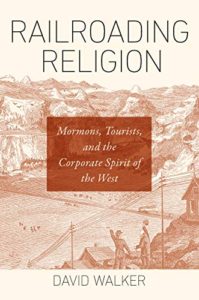 Review
Review
Title: Railroading Religion: Mormons, Tourists, and the Corporate Spirit of the West
Author: David Walker
Publisher: The University of North Carolina Press
Genre: History
Year Published: 2019
Number of Pages: 352
Binding: Paperback
LCCN 10: 2019011574
ISBN 13: 9781469653204
Price: $29.95
Reviewed by Gary McCary for the Association for Mormon Letters
Having grown up in a railroad town in the west, and having a lifelong love of religion and religious systems, I approached David Walkers’ “Railroading Religion” with much anticipation and relish. The little town of Needles, California where I grew up began and was sustained for decades because of the railroad. My grandfather, uncle and cousins worked on the railroad. I had an aunt who was a “Harvey Girl” for years at depots in both Needles and Barstow, California. And religion was a big part of the lives of railroad men and women in the mid 20th century of my formative years.
What David Walker does is show that a hundred years before I was born, there was both convergence and separation between railroads and religion, between secular society and a religious movement. Walker focuses on Mormonism’s ascendancy during the early railroad era in the Utah territory of the west. The epicenter of his historical narrative is the town of Corinne, Utah. It was a railroad town founded in late 1868 and early 1869 by a number of anti-Mormon businessmen. Many in America felt that the growing emergence of railroads would spell the end of this strange religion, the Church of Jesus Christ of Latter-day Saints. The vision of the men who built Corinne was that it would be a secular “city on a hill” that would eventually eclipse nearby Salt Lake City, becoming an alternative non-religious metropolis that would show the way to a future based on progress and rationality, and most importantly–secularity.
The transcontinental railroad was nearing completion, and that was seen as the final nail in the coffin of “Mormon Utah.” But reality–and the power of religion–has a strange way of causing the best laid plans of secularists to go awry. And that is what happened in Utah. It is a profound sense of irony that railroad-related alliances actually contributed to Mormonism’s survival and dominance in the region. Brigham Young, instead of fighting AGAINST the corporate railroad interests, decided to work WITH them. In return, the railroad companies actually became an ally for the church in its legal struggle for acceptance. The hub of the Transcontinental Railroad in Utah, rather than being in secularist Corinne, ended up in Ogden, much closer to the Utah capital city.
Walker brings all of this to life in a detailed, somewhat heavy fashion. He often uses dense scholarly terms resulting in a somewhat complicated narrative. As assistant professor of religious studies at the University of California, Santa Barbara, Walker appears to be writing to scholars of historical religious studies. Where he redeems himself for a general audience is in the summary pages at the end of each section. And his final conclusions are a rich historical overview of the unspoken contract that has always existed between secular and religious America. As Walker states in summation: “By 1893 Mormonism’s status was secure. It was as a religion of and for the railroad era.” Religious scholars and historians alike, after reading Walker, will be forced to rethink their presuppositions about the interconnectedness of the sacred and the secular. The narrative vehicle of religion and the railroad in 19th century Utah is a good launch point.
